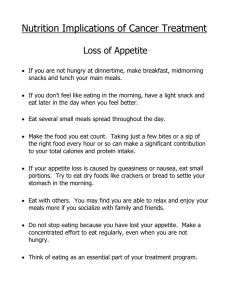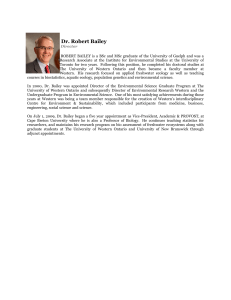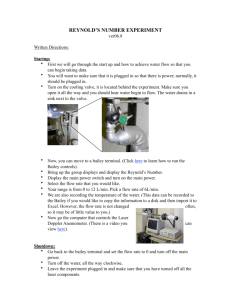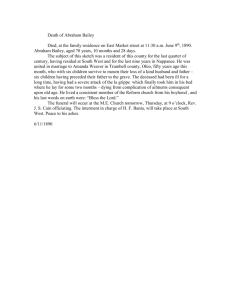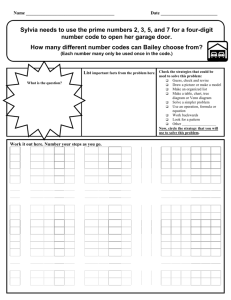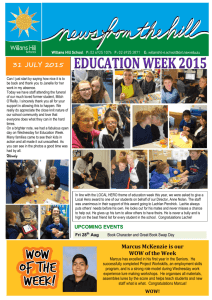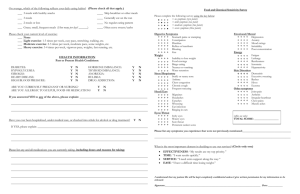Autoethnography Gretchen Bailey
advertisement
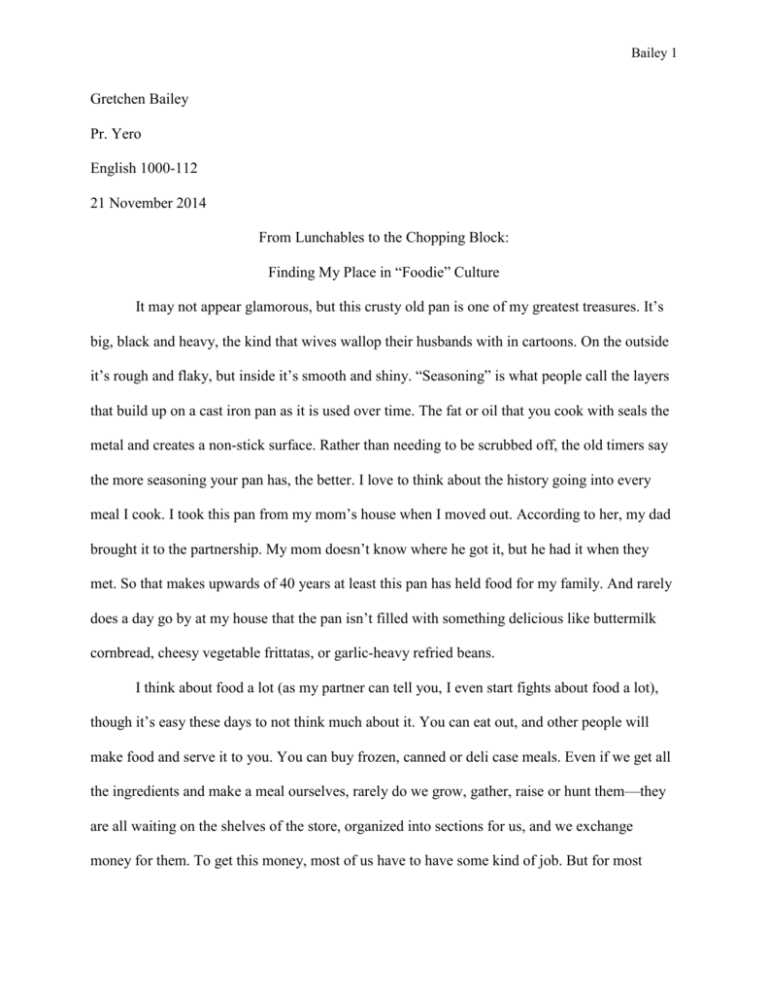
Bailey 1 Gretchen Bailey Pr. Yero English 1000-112 21 November 2014 From Lunchables to the Chopping Block: Finding My Place in “Foodie” Culture It may not appear glamorous, but this crusty old pan is one of my greatest treasures. It’s big, black and heavy, the kind that wives wallop their husbands with in cartoons. On the outside it’s rough and flaky, but inside it’s smooth and shiny. “Seasoning” is what people call the layers that build up on a cast iron pan as it is used over time. The fat or oil that you cook with seals the metal and creates a non-stick surface. Rather than needing to be scrubbed off, the old timers say the more seasoning your pan has, the better. I love to think about the history going into every meal I cook. I took this pan from my mom’s house when I moved out. According to her, my dad brought it to the partnership. My mom doesn’t know where he got it, but he had it when they met. So that makes upwards of 40 years at least this pan has held food for my family. And rarely does a day go by at my house that the pan isn’t filled with something delicious like buttermilk cornbread, cheesy vegetable frittatas, or garlic-heavy refried beans. I think about food a lot (as my partner can tell you, I even start fights about food a lot), though it’s easy these days to not think much about it. You can eat out, and other people will make food and serve it to you. You can buy frozen, canned or deli case meals. Even if we get all the ingredients and make a meal ourselves, rarely do we grow, gather, raise or hunt them—they are all waiting on the shelves of the store, organized into sections for us, and we exchange money for them. To get this money, most of us have to have some kind of job. But for most Bailey 2 living beings, including humans of the past, acquiring and eating food is one’s job! For us modern humans, genuine interest in food is considered a hobby. People who are passionate about food these days are known as “foodies.” This label includes many subcategories—there are the urban serial restaurant-goers who are always searching for the next amazing hole-in-the-wall, the hip chefs experimenting with expensive comfort food, the adventurous eaters who go out of their way to eat alligator and truffles. You could say I’m a foodie, though I don’t identify with the aforementioned types. I find the label itself distasteful—besides being an annoying word, it further defines a group who chooses food as its hobby, rather than a central aspect of life that is connected to all others. Engaging with pop-foodieism is a fun indulgence, but food for me is more central, more every-day and yet also more sacred than that. One of my food heroes, Jamie Oliver, has a mission to demystify cooking and empower the average Joe to learn basic techniques and buy fresh, seasonal ingredients. Eating this way, he says, is healthier, cheaper, and tastier (“Food Philosophy”). Not to mention its environmental and political effects. Good food is possible for people with busy lives and tight budgets, as well as those who have the ability to dine on fancy fricasseed pig’s foot. I grew up in Louisville, Kentucky, a city with every convenience, not having to think much about food. At the same time, I was lucky because unlike many of my friends’ parents, my mom and dad made homemade meals for us. My mom, like her own mother, was into fresh fruits and vegetables, fish, soups and stews, whole grains. She introduced me to a wide variety of healthy foods—she liked light meals and never cared for dessert. My dad was the one who got me into decadent things like dark chocolate, coffee, and puff pastry. I usually helped him when he made bran muffins, pancakes, rich coffee cake, and deserts like shiny hot fudge sauce or chocolate birthday cakes. He taught me to always cut the sugar. Sometimes his baked goods Bailey 3 would turn out weird because either he would forget an ingredient, or I would eat a quarter of the batter when he wasn’t looking. But privileged as we were to eat homemade meals, my sister and I would beg for the food other kids had at school. Candy that turned your tongue bright colors, neon drinks, Dunkaroos and Lunchables were what we wanted. Sometimes my mom would indulge us—I know we got Lunchables for a while. She got us mid-grade snacks like bagel bites, combos and toaster pastries with mysterious syrupy filling and white icing. But she probably knew we would thank her one day for feeding us more wholesomely than we wanted. Around age 12, I went vegetarian. I couldn’t stand the thought of eating the flesh of murdered animals. The heroes in most of the stories I read or watched were animals! In the dimly lit booths of restaurants, wreathed in cigarette smoke from the smoking section, I taunted my little sister as she ate her hamburgers, saying “Mooo! Mooo!” in a cute little voice. It used to make her cry, but I thought myself justified—that everyone should be forced to face the truth. I had decided that I wouldn’t eat meat again until I could be a part of its killing. In my late teens, I started being responsible for my own meals. At that time, most of my friends and I were vegans. That means that we ate no animal products, including meat, eggs and dairy. This diet choice was a response to learning about the terrible conditions of factory farming. It was quite a challenge to find prepared food that fit this diet. You could find me sitting on the white linoleum floor in Kroger, looking through a package’s fine print for lactose, rennet, or various other byproducts. Even “natural flavors” could mean something that was once animal. Reading labels taught me about the dubious nature of industrialized food, while a restricted diet and my small budget encouraged me to start cooking more. Bailey 4 When I was 21, I got the chance I was waiting for to be a part of killing animals for food and “break my veg.” I was part of a group that was adopting a “hundred mile diet” for four weeks in Oregon as part of a sustainable living skills program. Anything that we couldn’t get locally was out, including most spices, oil, sugar, tobacco, coffee… all the good stuff. We even took a field trip to the coast to gather our salt, which involved hours of stirring big metal pans of seawater and stoking the fires on the sand to evaporate it. We had to learn to bake our own sourdough bread, which required days of planning ahead and techniques that needed lots of practice. After all that work, when our clumsy loaves came out of the clay oven, they were always as hard and heavy as bricks, but we ate them anyway. But the biggest psychological shift for me was eating meat. I had feared this day. I was tense as I watched the ducks struggling in the unrelenting grip of human arms in their last minutes of being alive. I wouldn’t step forward and wield the hatchet this day, though a couple of the other young, squeamish Americans would. But to begin, Macorel from Haiti showed us how it was done at his home. He set the duck down with its feet on the earth, gently bent its head back and held it pinned behind its wings and sliced its throat– blood started to pour as he released the duck from his hands and it burst forth and ran wildly into the cornfield to die alone. We Americans were all crying while Macorel watched us with confusion. Next was the messy butchering and cleaning process with the smells and textures that made it hard to think of eating, and then cooking while also chopping wood for the clay stoves. Finally we sat down at the big table with a feast before us, featuring steaming duck stirfry with greens fresh from the garden—only a precious small serving per person. Full of a mixture of emotions, I blended the ducks’ bodies into my own. Bailey 5 This blending is the essence of my understanding of food not as a static thing but a process of transformation. Food is taking something living and incorporating it into something else living, releasing energy from one place and capturing it in another. As much or little as we think about it, we are all wrapped up in the food chain. Focusing on food has enabled me to learn first-hand about my place in the web of life and to develop my sense of ethics. Being human in addition to an animal, food is not only a necessity but also an art form. It gives us an opportunity to celebrate events and unique cultures, to carry the past into the present by making traditional recipes, and to bring people together. As the legendary food bible The Joy of Cooking puts it, “as a source of satisfaction and renewal, few daily rituals have the extraordinary potential of the act of preparing and sharing a meal” (Rombauer, Becker, and Becker 4). Above all, focusing on food is a grounding experience for me. When life gets complicated, eating a delicious meal is always a good place to start getting things back in order. Bailey 6 Works Cited Oliver, Jamie. “Food philosophy.” Jamie Oliver Official Website. n.p., n.d.Web. 12 November 2014. Rombauer, Irma S., Marion Rombauer Becker, and Ethan Becker. The Joy of Cooking. 1931. New York: Scribner, 2006. Print.
